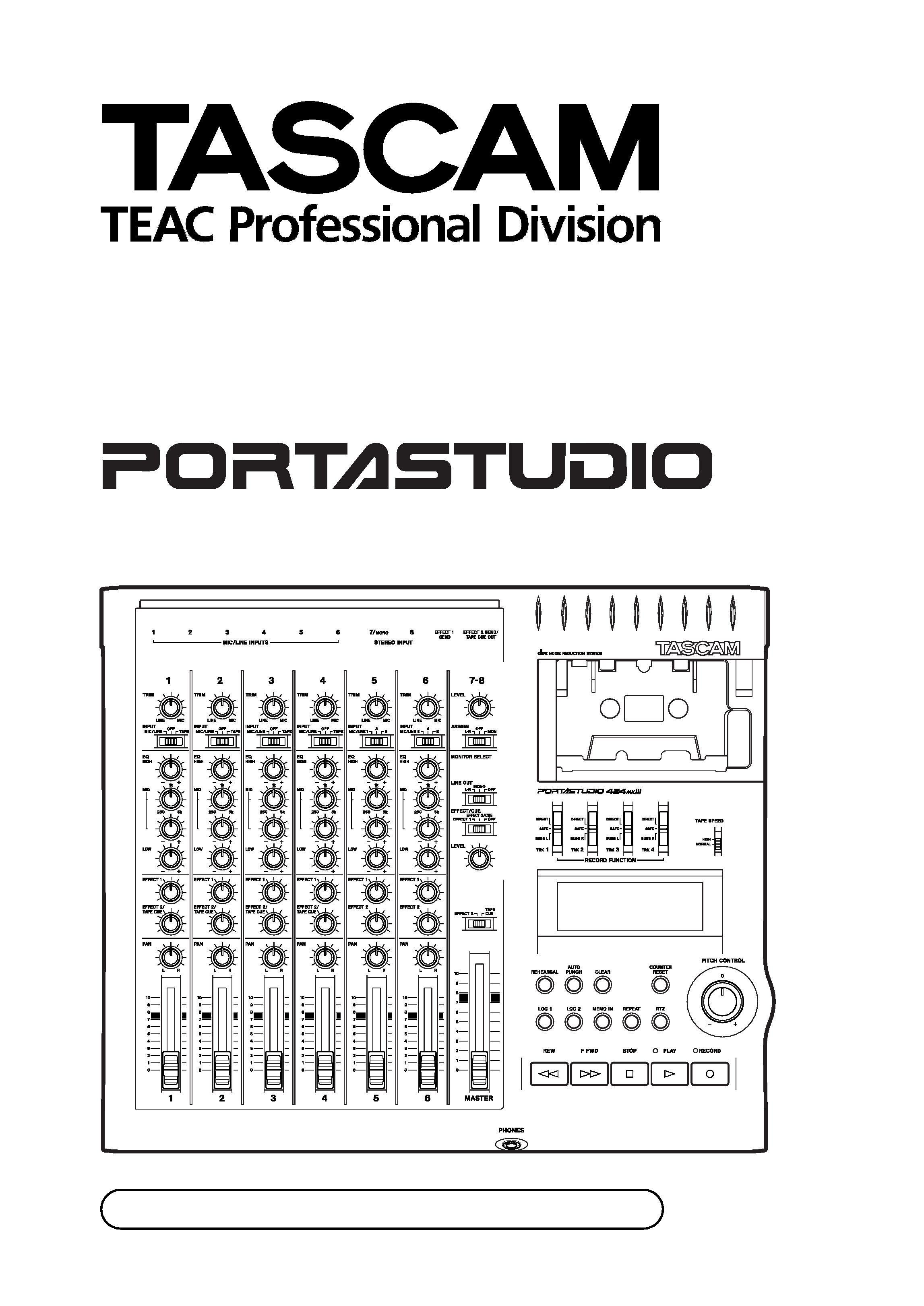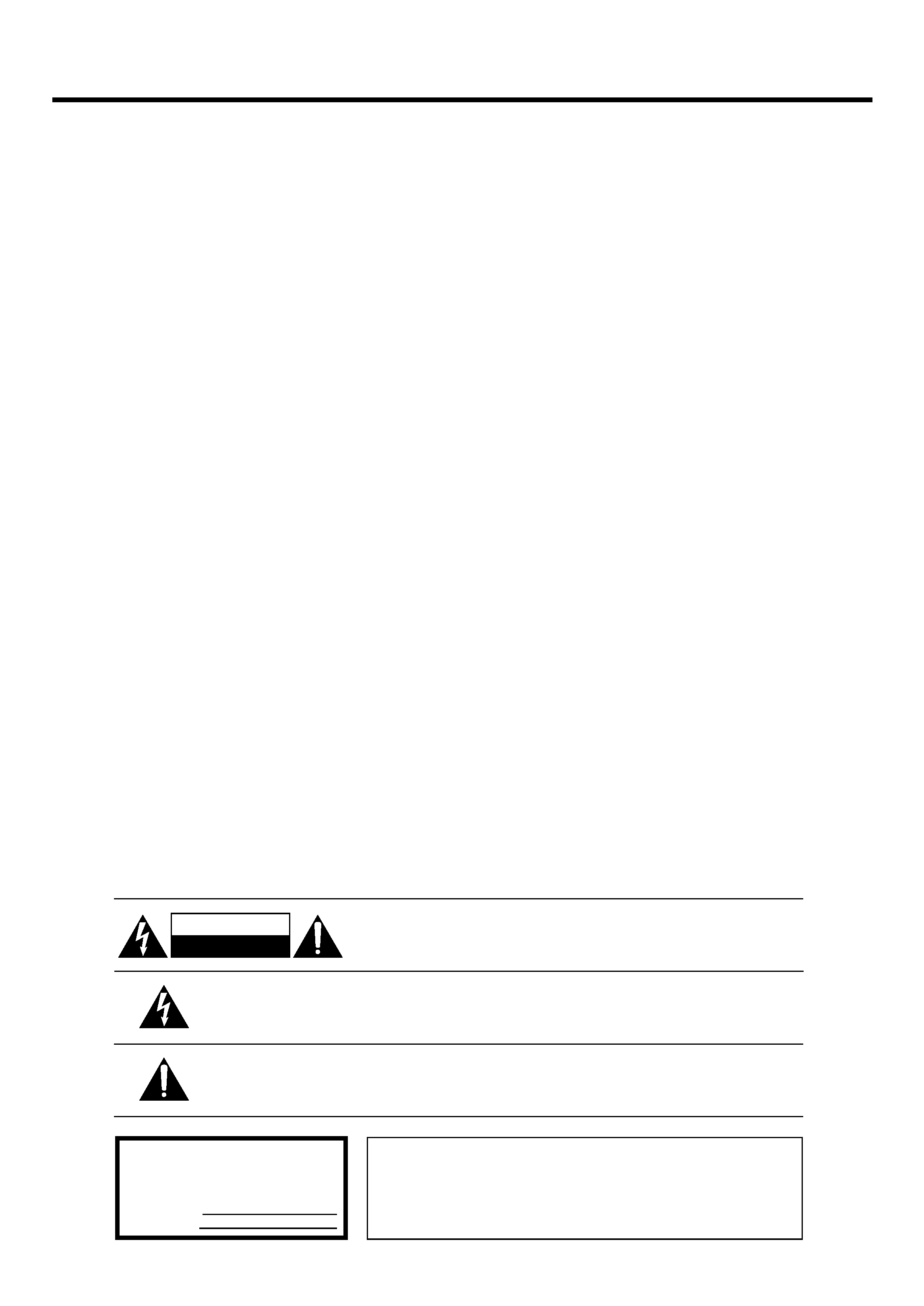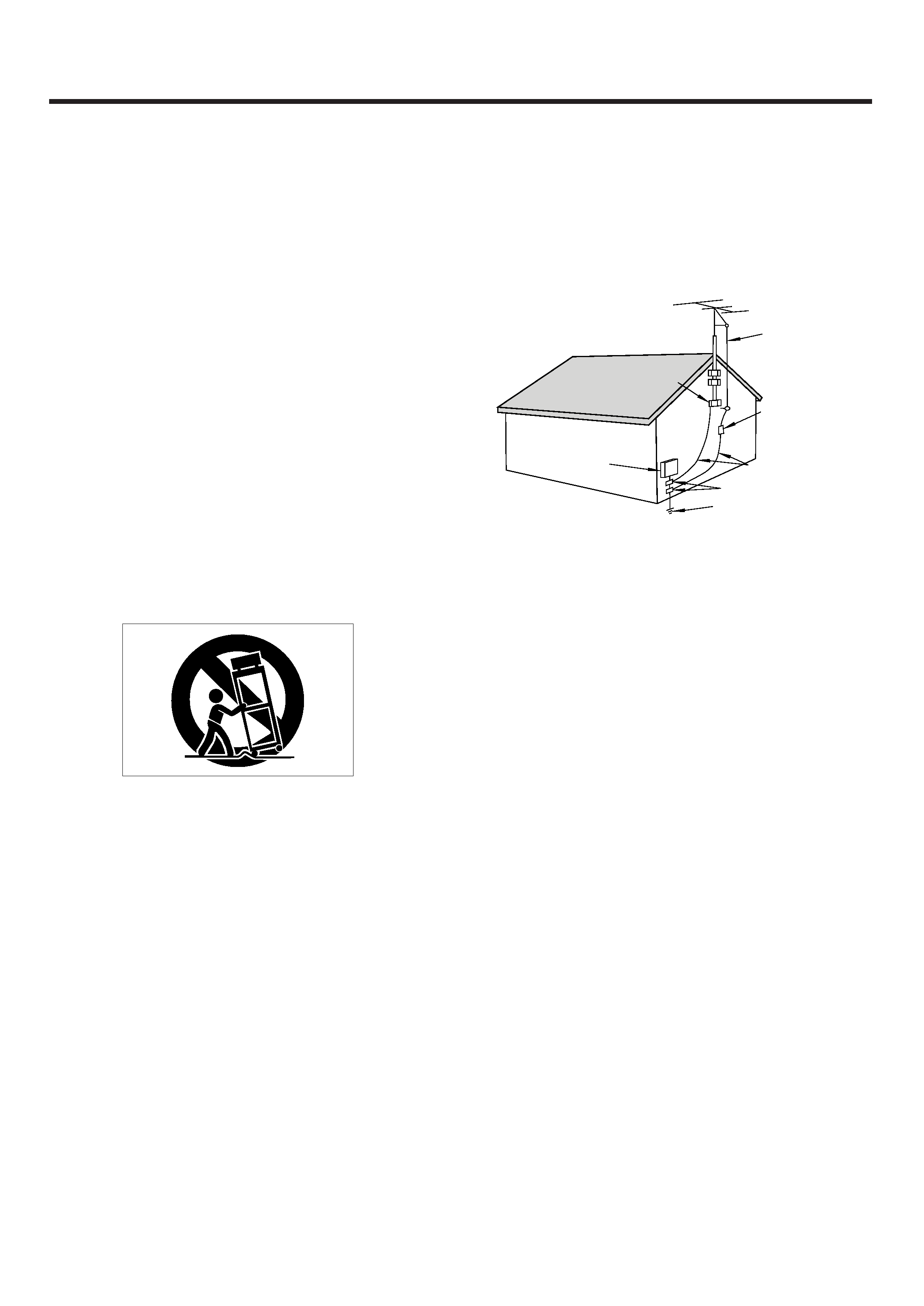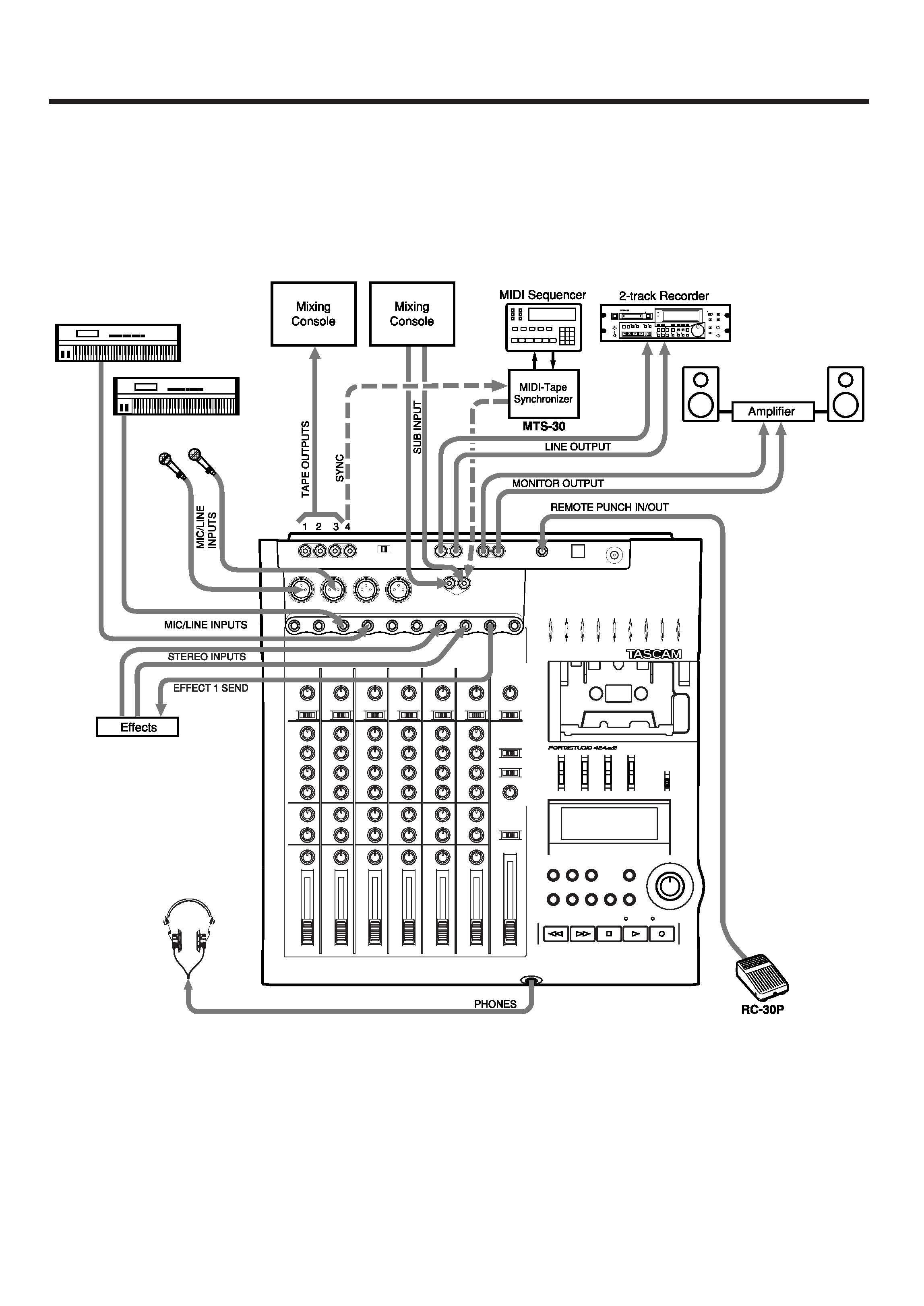
OWNER'S MANUAL
424@$
3D0023100A

2
Safety Instructions
3
Introduction
4
The Recording System
5
The three steps to multitrack
5
Understanding the Mixer
6-7
Signal flow in the 424 MKIII mixer
6
Tape cue monitor system
7
Multitrack Cassette Recorder
8
Track Format and Tape Recommendations
9-10
PORTASTUDIO 424 MKIII Brief Guide
11-14
Step-By-Step Operations Guide
15-24
Let's try the 424 MKIII mixer
15
How to record on track 1
16
Track 1 playback through TAPE CUE
18
How to make an overdub on track 2
19
How to record tracks 3 and 4
20
How to record many sources onto a
single track
20
How to record a mix onto two tracks
simultaneously
21
Recording on more than two tracks
simultaneously : DIRECT
22
How to mix down
23
Using Memory Location Points
25-26
Loading MEMO points
25
Locating the tape
26
Repeat Play
27
PUNCH-IN or INSERT Recording
28-32
Preliminary
28
Rehearsal and auto in/out procedures
29
Manual punch-in
31
Bouncing Tracks (Ping-Pong)
33-34
Ping-pong procedure
33
Using Effects with the
PORTASTUDIO 424 MKIII
35-36
Setting effect send levels
35
Setting the output level of effect devices
35
Setting the mix/balance control
on effect devices
35
How to connect your effects devices
36
Syncing MIDI-Tape--Using the
TASCAM MTS-30
37
Troubleshooting
38
Features and Controls
39-45
424 MKIII Mixer
Input section
40
Stereo input section
41
Monitor section
41
Master section
41
Output section
41
424 MKIII Recorder
Cassette loading and dbx system
42
Transport controls
43
Track controls
44
Displays
44
Autolocators
44
Optional Accessories
47
Care and Maintenance
48-49
How the dbx Works
49
Specifications
50-52
Block Diagram
53-54
Level Diagram
55
Table Of Contents
"© Copyright 1998, TEAC Corporation"
All rights reserved under international and Pan American copyright conventions.
This book may not be reproduced in whole or in part, by mimeograph or any other means,
without permission.
"The following marking is located on the bottom of the unit."
This appliance has a serial number located
on the rear panel. Please record the model
number and serial number and retain them
for your records.
Model number
Serial number
WARNING: TO PRIVENT FIRE OR SHOCK
HAZARD, DO NOT EXPOSE THIS
APPLIANCE TO RAIN OR MOISTURE.
CAUTION: TO REDUCE THE RISK OF ELECTRIC SHOCK, DO NOT
REMOVE COVER (OR BACK). NO USER-SERVICEABLE PARTS
INSIDE. REFER SERVICING TO QUALIFIED SERVICE PERSONNEL.
The lightning flash with arrowhead symbol, within equilateral triangle, is intended to alert
the user to the presence of uninsulated "dangerous voltage" within the product's enclosure
that may be of sufficient magnitude to constitute a risk of electric shock to person.
The exclamation point within an equilateral triangle is intended to alert the user to the
presence of important operating and maintenance (servicing) instructions in the
literature accompanying the appliance.
CAUTION
RISK OF ELECTRIC SHOCK
DO NOT OPEN

3
Safety Instructions
CAUTION:
· Read all of these Instructions.
· Save these Instructions for later use.
· Follow all Warnings and Instructions marked on the
audio equipment.
1) Read instructions -- All the safety and operating instructions
should be read before the product is operated.
2) Retain instructions -- The safety and operating instructions should
be retained for future reference.
3) Heed Warnings -- All warnings on the product and in the operating
instructions should be adhered to.
4) Follow instructions -- All operating and use instructions shoud be
followed.
5) Cleaning -- Unplug this product from the wall outlet before cleaning.
Do not use liquid cleaners or aerosol cleaners. Use a damp cloth for
cleaning.
6) Attachments -- Do not use attachments not recommended by the
product manufacturer as they may cause hazards.
7) Water and Moisture -- Do not use this product near water _ for
example, near a bath tub, wash bowl, kitchen sink, or laundry tub; in a wet
basement; or near a swimming pool; and the like.
8) Accessories -- Do not place this product on an unstable cart, stand,
tripod, bracket, or table. The product may fall, causing serious injury to a
child or adult, and serious damage to the product. Use only with a cart,
stand, tripod, bracket, or table recommended by the manufacturer, or sold
with the product. Any mounting of the product should follow the
manufacturer's instructions, and should use a mounting accessory
recommended by the manufacturer.
9) A product and cart combination should be moved with care. Quick
stops, excessive force, and uneven surfaces may cause the product and cart
combination to overturn.
10) Ventilation -- Slots and openings in the cabinet are provided for
ventilation and to ensure reliable operation of the product and to protect it
from overheating, and these openings must not be blocked or covered. The
openings should never be blocked by placing the product on a bed, sofa,
rug, or other similar surface. This product should not be placed in a built-in
installation such as a bookcase or rack unless proper ventilation is provided
or the manufacturer's instructions have been adhered to.
11) Power Sources -- This product should be operated only from the
type of power source indicated on the marking label. If you are not sure of
the type of power supply to your home, consult your product dealer or local
power company. For products intended to operate from battery power, or
other sources, refer to the operating instructions.
12) Grounding or Polarization -- This procuct may be equipped with
a polarized alternating-current line plug (a plug having one blade wider
than the other). This plug will fit into the power outlet only one way. This
is a safety feature. If you are unable to insert the plug fully into the outlet,
try reversing the plug. If the plug should still fail to fit, contact your
electrician to replace your obsolete outlet. Do not defeat the safety purpose
of the polarized plug.
13) Power-Cord Protection -- Power-supply cords shoud be routed so
that they are not likely to be walked on or pinched by items placed upon or
against them, paying particular attention to cords at plugs, convenience
receptacles, and the point where they exit from the product.
14) Outdoor Antenna Grounding -- If an outside antenna or cable
system is connected to the product, be sure the antenna or cable system is
grounded so as to provide some protection against voltage surges and built-
up static charges. Article 810 of the National Electrical Code, ANSI/NFPA
70, provides information with regard to proper grounding of the mast and
supporting structure, grounding of the lead-in wire to an antenna discharge
unit, size of grounding conductors, location of antenna-discharge unit,
connection to grounding electrodes, and requirements for the grounding
electrode.
"Note to CATV system installer:
This reminder is provided to call the CATV system installer's attention to
Section 820-40 of the NEC which provides guidelines for proper grounding
and, in particular, specifies that the cable ground shall be connected to the
grounding system of the building, as close to the point of cable entry as
practical.
15) Lightning -- For added protection for this product during a lightning
storm, or when it is left unattended and unused for long periods of time,
unplug it from the wall outlet and disconnect the antenna or cable system.
This will prevent damage to the product due to lightning and power-line
surges.
16) Power Lines -- An outside antenna system should not be located in
the vicinity of overhead power lines or other electric light or power circuits,
or where it can fall into such power lines or circuits. When installing an
outside antenna system, extreme care should be taken to keep from
touching such power lines or circuits as contact with them might be fatal.
17) Overloading -- Do not overload wall outlets, extension cords, or
integral convenience receptacles as this can result in risk of fire or electric
shock.
18) Object and Liquid Entry -- Never push objects of any kind into
this product through openings as they may touch dangerous voltage points
or short-out parts that could result in a fire or electric shock. Never spill
liquid of any kind on the product.
19) Servicing -- Do not attempt to service this product yourself as
opening or removing covers may expose you to dangerous voltage or other
hazards. Refer all servicing to qualified service personnel.
20) Damage Requiring Service -- Unplug this product from the wall
outlet and refer servicing to qualified service personnel under the following
conditions:
a) when the power-supply cord or plug is damaged.
b) if liquid has been spilled, or objects have fallen into the product.
c) if the product has been exposed to rain or water.
d) if the product does not operate normally by following the operating
instructions. Adjust only those controls that are covered by the operating
instructions as an improper adjustment of other controls may result in
damage and will often require extensive work by a qualified technician to
restore the product to its normal operation.
e) if the product has been dropped or damaged in any way.
f ) when the product exhibits a distinct change in performance _ this
indicates a need for service.
21) Replacement Parts -- When replacement parts are required, be
sure the service technician has used replacement parts specified by the
manufacturer or have the same characteristics as the original part.
Unauthorized substitutions may result in fire, electric shock, or other
hazards.
22) Safety Check -- Upon completion of any service or repairs to this
product, ask the service technician to perform safety checks to determine
that the product is in proper operating condition.
23) Wall or Ceiling Mouting -- The product shoud be mounted to a
wall or ceiling only as recommended by the manufacturer.
24) Heat -- The product should be situated away from heat sources such
as radiators, heat registers, stoves, or other products (including amplifiers)
that produce heat.
ANTENNA
LEAD IN
WIRE
ANTENNA
DISCHARGE UNIT
(NEC SECTION 810-20)
G
ROUNDING CONDUCTORS
(NEC SECTION 810-21)
GROUND CLAMPS
POWER SERVICE GROUNDING
ELECTRODE SYSTEM
(NEC ART 250. PART H)
NEC - NATIONAL ELECTRICAL CODE
ELECTRIC
SERVICE
EQUIPMENT
Example of Antenna Grounding as per
National Electrical Code, ANSI/NFPA 70
GROUND
CLAMP

Using this manual : To get the most out of your
424 MKIII, please take the time to read through
this manual. Some time spent now will keep you
from overlooking some of the features that make
the 424 MKIII a more creative tool. You may
discover some new tricks you haven't tried
before.
Use of capital letters : In general, we use all upper
case type to designate a particular switch,
control, jack name or label (like PAN). Transport
modes and some features are described with an
upper case first letter (like Record mode).
The PORTASTUDIO 424 MKIII is...
The PORTASTUDIO 424 MKIII is a 4-track
"Multitrack Master" cassette tape recorder and a
full-function mixer with 8 inputs/stereo outputs
combined into a single workstation.
Its high audio quality and creative flexibility
reflect the experience and innovation that have
allowed TASCAM to earn its reputation in
professional audio production fields, and its user-
friendly design makes the 424 MKIII suitable for
anyone, from expert to novice.
NOTE FOR U.K. CUSTOMERS
DO NOT cut off the mains plug from this
equipment. If the plug fitted is not suitable for the
power points in your home or the cable is too
short to reach a power point, then obtain an
appropriate safety approved extension lead or
consult your dealer.
If nonetheless the mains plug is cut off, remove
the fuse and dispose of the plug immediately, to
avoid a possible shock hazard by inadvertent
connection to the mains supply.
If this product is not provided with a mains plug,
or one has to be fitted, then follow the
instructions given below:
IMPORTANT. DO NOT make any connection to
the larger terminal which is marked with the letter
E or by the safety earth symbol
ç or coloured
GREEN or GREEN-and-YELLOW.
The wires in the mains lead on this product are
coloured in accordance with the following code:
BLUE:
NEUTRAL
BROWN:
LIVE
Introduction
CAUTION : TO PREVENT ELECTRIC SHOCK,
MATCH WIDE BLADE OF PLUG TO WIDE
SLOT, FULLY INSERT
ATTENTION : POUR ÉVITER LES CHOCS
ÉLECTRIQUES, INTRODUIRE LA LAME LA
PLUS LARGE DE LA FICHE DANS LA BORNE
CORRESPONDANTE DE LA PRISE ET
POUSSER JUSQU' AU FOND.
About the weld line
There is a patterned stripe-like effect on the
bottom surface of the 424 unit. This effect is
called a "weld line" and is a natural result of
the resin molding process employed in the
manufacture of the 424 unit. It is not a crack
or scratch, and will cause no problems with
the operation of the 424 unit.
As these colours may not correspond with the
coloured markings identifying the terminals in
your plug proceed as follows:
The wire which is coloured BLUE must be
connected to the terminal which is marked with
the letter N or coloured BLACK.
The wire which is coloured BROWN must be
connected to the terminal which is marked with
the letter L or coloured RED.
When replacing the fuse only a correctly rated
approved type should be used and be sure to re-
fit the fuse cover.
IF IN DOUBT -- CONSULT A COMPETENT
ELECTRICIAN.
4

5
The PORTASTUDIO 424 MKIII is a complete audio
production facility in a single box. It is divided
into two major sections: a full-function mixer and
an 4-channel, multitrack cassette recorder.
To complete the recording system, you'll
additionally
need
these:
Input
devices
(microphones, instruments), Output devices
(headphones),
2
track
recorder,
Effects
processors, etc.
The Recording System
The Three Steps to Multitrack
In TRACKING and Overdubbing, the mixer inputs
are usually microphones or instruments, going to
different tracks of the recorder.
In OVERDUBBING, the MONITOR section and
TAPE CUE of the mixer must be used to listen to
previous tracks while you record new ones, so
there is a two-way flow through the console.
In MIXDOWN, signal comes from the multitrack
and is sent to an external 2-track recorder.
